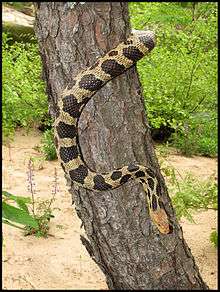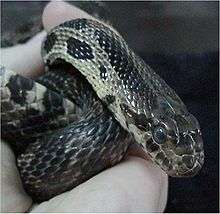Pantherophis vulpinus
| Pantherophis vulpinus | |
|---|---|
 | |
| Western fox snake descending a jack pine in Eau Claire County, Wisconsin. | |
| Scientific classification | |
| Kingdom: | Animalia |
| Phylum: | Chordata |
| Subphylum: | Vertebrata |
| Class: | Reptilia |
| Order: | Squamata |
| Suborder: | Serpentes |
| Family: | Colubridae |
| Subfamily: | Colubrinae |
| Genus: | Pantherophis |
| Species: | P. vulpinus |
| Binomial name | |
| Pantherophis vulpinus (Baird & Girard, 1853) | |
| Synonyms | |
| |
Pantherophis vulpinus, commonly known as the western foxsnake[1] or western fox snake, is a species of nonvenomous colubrid snake, which is endemic to North America.
Description

Adult western foxsnakes are 3 to 6 feet (0.91 to 1.83 m) in total length (including tail), and have a short, flattened snout. Dorsally, they are usually light golden brown with dark brown spots, and they have a yellow checkerboard pattern on the belly.
Like most North American snakes, foxsnakes are not venomous. Foxsnakes earned their name because the musk they give off when threatened smells similar to a fox.[2]
Geographic range
Pantherophis vulpinus is found in the upper midwestern United States, from Wisconsin west to South Dakota and south to Illinois and Indiana.
The geographic range of the closely related eastern foxsnake (Pantherophis gloydi) skirts the Great Lakes in Michigan, Ohio, and Ontario. The two species do not overlap, and there is no intergrade zone.
Habitat
Varied, including open woodland, prairie, farmland, pastures, and marshlands.
Behavior
These strong, agile snakes are also excellent climbers but are more often found on the ground. Foxsnakes are diurnal, but may hunt at night during the hot summer months. Like all snakes, foxsnakes are cold-blooded and cannot adjust their own body temperature; so these snakes often hide in burrows or under logs or rocks to stay safe from extremely hot or cold weather. In winter, they hibernate underground, where they can avoid freezing temperatures.
These docile, harmless snakes use several defensive behaviors against predators. They may shake their tails in dry leaves, sounding like rattlesnakes.[3] They can also give off a stinky musk from glands near their tail, which makes them less appetizing to other animals. This musk has an odor similar to that of the red fox; this is the origin of the common name "fox snake".[4] As a last resort, these snakes may hiss loudly and strike at the threat.
Diet
Like all snakes, foxsnakes are strict carnivores. Their primary diet consists of mice and other small rodents, but they will take any prey small enough to swallow whole, including young rabbits, frogs, fledglingbirds, and eggs. As constrictors, they subdue their prey by squeezing it between their coils.
Life history
Foxsnakes mate in April and May. Males wrestle with one another for the right to mate with females. In June, July, or August, the female will bury a clutch of 7 to 27 eggs under a log or in debris on the forest floor. These hatch after an approximately 60 day incubation period. Young foxsnakes are usually much lighter in color than adults.
They are often a welcome sight around farmland, where they consume a large number of rodents that can otherwise be harmful to crops, or transmit parasites to captive animal stocks. Though, they are opportunistic feeders, and will sometimes also eat fledgling chickens or eggs, which sometimes leads them to be erroneously called the chicken snake.
Conservation status
The western foxsnake is not listed on the IUCN Red List of Threatened and Endangered Species or CITES. While this snake is common within its range, many states have protected it, primarily to prevent over-collection for the pet trade.
References
- ↑ Crother BI (editor). 2008. Scientific and Standard English Names of Amphibians and Reptiles of North America North of Mexico. Society for the Study of Amphibians and Reptiles Herpetological Circular 37. 84 pp.PDF at SSAR. Accessed 4 July 2011.
- ↑ Morris PA. 1948. Boy's Book of Snakes, How to Recognize and Understand Them. A volume of the Humanizing Science Series, edited by Jaques Cattell. New York: Ronald Press. viii + 185 pp. (Elaphe vulpina vulpina, pp. 90-91, 180).
- ↑ Schmidt KP, Davis DD. 1941. Field Book of Snakes of the United States and Canada. New York: G.P. Putnam's Sons. 365 pp. (Elaphe vulpina vulpina, pp. 153-155, Figure 42 + Plates 5, 17).
- ↑ "Western Fox Snake: Minnesota DNR". www.dnr.state.mn.us. Retrieved 25 September 2016.
Further reading
- Baird SF, Girard CF. 1853. Catalogue of North American Reptiles in the Museum of the Smithsonian Institution. Part I.—Serpents. Washington, District of Columbia: Smithsonian Institution. xvi + 172 pp. (Scotophis vulpinus, new species, pp. 75–76).
- Behler JL, King FW. 1979 (1994). National Audubon Society Field Guide to North American Reptiles and Amphibians. New York: Knopf. 743 pp. ISBN 0-394-50824-6. (Elaphe vulpina, pp. 608–609).
- Boulenger GA. 1894. Catalogue of the Snakes in the British Museum (Natural History). Volume II., Containing the Conclusion of the Colubridæ Aglyphæ. London: Trustees of the British Museum (Natural History). (Taylor and Francis, printers). xi + 382 pp. + Plates I-XX. (Coluber vulpinus, p. 49).
- Conant R. 1975. A Field Guide to Reptiles and Amphibians of Eastern and Central North America, Second Edition. Boston: Houghton Mifflin. xviii + 429 pp. + Plates 1-48. ISBN 0-395-19979-4 (hardcover), ISBN 0-395-19977-8 (paperback). (Elaphe vulpina vulpina, pp. 191–193, Figure 44 + Plate 28 + Map 148).
- Conant R, Bridges W. 1939. What Snake is That?: A Field Guide to the Snakes of the United States East of the Rocky Mountains. New York and London: D. Appleton-Century. Frontispiece map + 163 pp. + Plates A-C, 1-32. (Elaphe vulpina, pp. 62–63 + Plate 9, Figure 26).
- Harding JH. 1997. Amphibians and Reptiles of the Great Lakes Region. Ann Arbor: University of Michigan Press. 400 pp. ISBN 0472066285.
- Smith HM, Brodie ED Jr. 1982. Reptiles of North America: A Guide to Field Identification. New York: Golden Press. 240 pp. ISBN 0-307-13666-3. (Elaphe vulpina pp. 186–187).
- Wright AH, Wright AA. 1957. Handbook of Snakes of the United States and Canada. Ithaca and London: Comstock. 1,105 pp. (in 2 volumes). (Elaphe vulpina vulpina, pp. 262–266, Figure 81 + Map 23 on p. 223).
- Zim HS, Smith HM. 1956. Reptiles and Amphibians: A Guide to Familiar American Species: A Golden Nature Guide. New York: Simon and Schuster. 160 pp. (Elaphe vulpina, pp. 92–93, 156).
| Wikimedia Commons has media related to Pantherophis vulpina. |